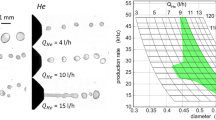Abstract
Various aspects of the design and operation of a full-scale helium-filled soap bubble generator are studied. Shadowgraphy, particle image/tracking velocimetry, hotwire anemometry, and Monte Carlo simulations are employed to investigate bubble production regimes, diameters, production rates, time responses, and the flow quality downstream from the full-scale system. Modifications to internal nozzle geometry are found to greatly impact the production regimes that the nozzles operate within. Specifically, improving the axisymmetry of the air flow within a nozzle leads to desirable bubble formation over a larger range of input combinations and the ability to operate at larger input rates in general. The input of bubble film solution (BFS) is also found to be important for ensuring proper operation, as both small and large inputs lead to undesirable production. A previously defined theoretical relationship (Faleiros et al., Exp Fluids 60:40, 2019) between input parameters and the mean bubble time response is confirmed but found to vary depending on nozzle operation, as spilled BFS and leaked helium during bubble formation cause deviation from theoretical operation. Monte Carlo simulations reveal that the spatial filtering of particle image velocimetry (PIV) reduces the standard deviation of the effective distribution of the bubble time responses by a factor of \({\text{PPIR}}^{ - 1/2}\), where PPIR is the number of particles per interrogation region. This power law is used to derive an equation for estimating the minimum time scale of the flow that can be resolved using the bubbles from a given generator during applications of PIV. Finally, the wind tunnel flow downstream from a full-scale generator is found to be affected by the blockage of the structure, with the freestream deficit increasing by at most 1.2% of the mean and the freestream turbulence intensity increasing by at most 0.3% for freestream velocities of 6 m/s or greater.
Graphic abstract
















Similar content being viewed by others
References
Bosbach J, Kühn M, Wagner C (2009) Large scale particle image velocimetry with helium filled soap bubbles. Exp Fluids 46:539–547
Caridi GCA, Ragni D, Sciacchitano A, Scarano F (2016) HFSB-seeding for large-scale tomographic PIV in wind tunnels. Exp Fluids 57:190
Caridi GCA, Sciacchitano A, Scarano F (2017) Helium-filled soap bubbles for vortex core velocimetry. Exp Fluids 58:130
Elsinga GE, Scarano F, Wieneke B, van Oudheusden BW (2006) Tomographic particle image velocimetry. Exp Fluids 41:933–947
Faleiros DE, Tuinstra M, Sciacchitano A, Scarano F (2018) Helium-filled soap bubbles tracing fidelity in wall-bounded turbulence. Exp Fluids 59:56
Faleiros DE, Tuinstra M, Sciacchitano A, Scarano F (2019) Generation and control of helium-filled soap bubbles for PIV. Exp Fluids 60:40
Gibeau B, Ghaemi S (2018) A modular, 3D-printed helium-filled soap bubble generator for large-scale volumetric flow measurements. Exp Fluids 59:178
Hale RW, Tan P, Stowell RC, Ordway DE (1971) Development of an integrated system for flow visualization in air using neutrally-buoyant bubbles. In: SAI-RR 7107. Sage Action Inc, Ithaca
Huhn F, Schanz D, Gesemann S, Dierksheide U, van de Meerendonk R, Schröder A (2017) Large-scale volumetric flow measurement in a pure thermal plume by dense tracking of helium-filled soap bubbles. Exp Fluids 58:116
Jux C, Sciacchitano A, Schneiders JFG, Scarano F (2018) Robotic volumetric PIV of a full-scale cyclist. Exp Fluids 59:74
Keane RD, Adrian RJ (1992) Theory of cross-correlation analysis of PIV images. Appl Sci Res 49:191–215
Kerho MF, Bragg MB (1994) Neutrally buoyant bubbles used as flow tracers in air. Exp Fluids 16:393–400
Kühn M, Ehrenfried K, Bosbach J, Wagner C (2011) Large-scale tomographic particle image velocimetry using helium-filled soap bubbles. Exp Fluids 50:929–948
Meinhart CD, Wereley ST, Santiago JG (2000) A PIV algorithm for estimating time-averaged velocity fields. J Fluids Eng 122:285–289
Müller D, Müller B, Renz U (2001) Three-dimensional particle-streak tracking (PST) velocity measurements of a heat exchanger inlet flow. Exp Fluids 30:645–656
Raffel M, Willert CE, Scarano F, Kähler C, Wereley ST, Kompenhans J (2018) Particle image velocimetry: a practical guide. Springer, Berlin
Scarano F (2013) Tomographic PIV: principles and practice. Meas Sci Technol 24:012001
Scarano F, Ghaemi S, Caridi GCA, Bosbach J, Dierksheide U, Sciacchitano A (2015) On the use of helium-filled soap bubbles for large-scale tomographic PIV in wind tunnel experiments. Exp Fluids 56:42
Terra W, Sciacchitano A, Scarano F (2017) Aerodynamic drag of a transitioning sphere by large-scale tomographic-PIV. Exp Fluids 58:83
Tropea C, Yarin AL, Foss J (2007) Handbook of experimental fluid mechanics. Springer, Berlin
Acknowledgements
We acknowledge the support of the Natural Sciences and Engineering Research Council of Canada (NSERC) (Alexander Graham Bell Canada Graduate Scholarship—Doctoral). We also thank Dr. Markus Raffel of the German Aerospace Centre (DLR) for insightful discussions regarding nozzle design, and Prof. David Wood of the University of Calgary for lending the hotwire anemometry system used in this study.
Author information
Authors and Affiliations
Corresponding author
Additional information
Publisher's Note
Springer Nature remains neutral with regard to jurisdictional claims in published maps and institutional affiliations.
Rights and permissions
About this article
Cite this article
Gibeau, B., Gingras, D. & Ghaemi, S. Evaluation of a full-scale helium-filled soap bubble generator. Exp Fluids 61, 28 (2020). https://doi.org/10.1007/s00348-019-2853-8
Received:
Revised:
Accepted:
Published:
DOI: https://doi.org/10.1007/s00348-019-2853-8




